INTRODUCTION
Goat is one of the important industries in the agro-food subsector in Malaysia. In 2017, the value of this industry is about RM175.55 million (US$42.81 million). Goat provides nutrition for Malaysian people through the supply of meats and milk. However, the goat industry in Malaysia is relatively small. Currently, the population of goats and sheep in Malaysia is around 572,000 animals that could supply around 4,600 MT of mutton a year. On the other hand, the consumption of mutton in Malaysia is around 40,388 MT a year. As a result, Malaysia imports around 51,150 live goats and sheep, and 34,984 MT of mutton mainly from Australia, New Zealand, South Africa and India. The Malaysian government aims to increase the production of mutton so as to reduce the dependency of meats from foreign countries. Many plans and initiatives have been spelled out in the Malaysian Development Plan and the National Agricultural Policy. This paper highlights one of the initiatives of the Malaysian Agricultural Research and Development Institute (MARDI) towards the development of better goat breeds in Malaysia.
Production and consumption
Production of ruminant livestock such as beef and mutton in Malaysia has shown an increasing trend from 1960 to 2017 (Table 1). In year 2000 up to 2010, the changes of beef and mutton production was the highest percentage of 158.37% and 160.70% respectively. This positive growth was mainly contributed by the rearing of cattle and goats in plantations and also feedlot cattle raised by the private sector (Nor Amna and Mohamad Hifzan, 2015). Additionally, it was also affected by the large expense for livestock, especially ruminants’ sub-sector in the 9th Malaysia Development Plan (RMK-9). A total of RM519.8 million (US$126.8 million) of the total agricultural development budget was allocated by the government to the livestock sector for a period of five years (Mohamed, 2007).
Table 1. Production of beef and mutton in Peninsular Malaysia, 1960 - 2017
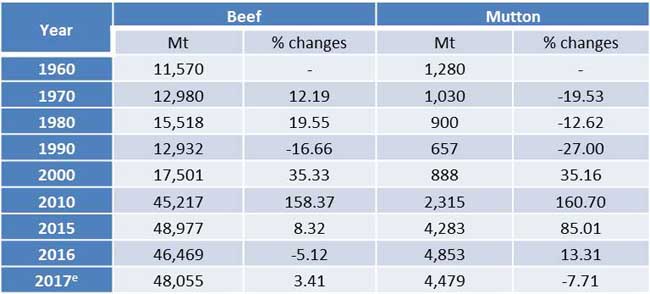
e: estimate
Source: Mohamed (2014); Department of Veterinary Services, Malaysia (2018)
The demand for meat in Malaysia shows a higher growth rate if compared with the supply (Table 2). The production of mutton has decreased from time to time. Only quite lately, the production has increased tremendously after the government took special attention and provided incentives. At the same time, the demand for mutton has increased continuously. For example, in 2017, despite the reduction of production by 7.7%, the consumption of mutton has increased around 5.06%.
Table 2. The consumption of beef and mutton in Peninsular Malaysia, 1960 - 2017

Source: Mohamed (2014); Department of Veterinary Services, Malaysia (2018)
The higher demand for meat and meat-based products is associated with higher purchasing power by Malaysian consumers, as well as an increase in the number of population in general. This positive trend can be seen in per capita consumption (Table 3). Before 2010, the per capita consumption of mutton has remained stagnant at below one kilogram per annum. This is affected by the misconception that mutton is high in cholesterol and saturated fats (Kaur, 2010). However, in 2015 and above, the per capita consumption has been more than one kilogram. This shows that, Malaysians began to change their perception and choose mutton as their diet. Per capita consumption of beef, mutton, pork and poultry continue to rise as society growing affluence and having higher purchasing power.
Table 3. Per capita consumption of meat in Peninsular Malaysia (kg), 1993-2017

Source: Mohamed (2014); Department of Veterinary Services, Malaysia (2018)
Livestock trade
Most of livestock products in Malaysia, except for poultry, rely on imports to satisfy its domestic demands . Compared to other meats, beef is the most imported meat in Malaysia. It is due to cheaper price compared to the local beef price and also has a high demand from Malaysian consumers. The value of imported mutton during the period of 2015 and 2016 is relatively high, RM469 million (US$114.4 million) in 2015 and just decreased a bit to RM454.17 million in 2016 (US$110.8 million) (Table 4).
Table 4. Import Value of Livestock and Livestock Products in Malaysia, 2015 - 2016
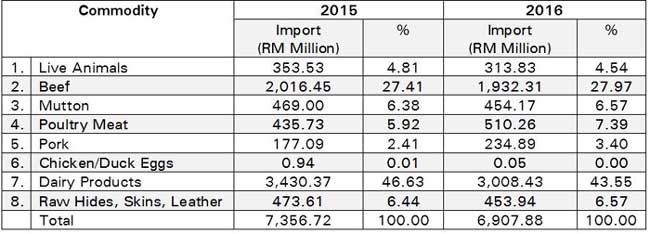
Source: Ministry of Agriculture and Agro-Based Industry Malaysia
Although mutton production has increased over the past eight years, Malaysia is still unable to meet the mutton demand for its population, as well as for export purposes. The number of exports for mutton is very small as shown in the Table 5. Hence, this leads to a negative trade balance value. Indeed, the balance of trade for live animals (for consumption) and meat as a whole is negative, with the negative value of RM2,567.49 million (US$626.2 million) for live animals and RM1,779.05 (US$433.9 million) for meat in 2016 (Department of Veterinary Services, 2018).
Table 5. Export Value of Mutton, Live Sheep and Live Goats in Malaysia, 2012 - 2016

Source: Ministry of Agriculture and Agro-Based Industry Malaysia
Government intervention on goat industry
The Government of Malaysia, through the Ministry of Agriculture and Agro-based Industry, has outlined a number of new measures and approaches to strengthen the Malaysian livestock industry. In the 9th Malaysia Plan (2006-2010), several large-scale projects have been developed to increase the population of cattle and goats. While in the 10th Malaysia Plan (2011-2015), livestock was also given priority in the Northern Corridor Economic Region (NCER), East Coast Economic Region (ECER), the Sarawak Corridor of Renewable Energy (SCORE) and the Sabah Development Corridor (SDC). During the 10th Malaysia Plan period, livestock was also focused on economic growth efforts in the National Key Economic Areas (NKEA). In agriculture’s NKEA, 16 Entry Point Projects (EPPs) have been identified to catalyze the establishment of market-driven, industrial scale and integrated-related business. Some of these EPPs are focusing on the livestock sector. Most recently, the 11th Malaysia Plan (RMK-11) focuses on research and development (R&D) especially on agricultural practices that take into account the climate change and Good Agricultural Practices (GAPs). It will be expanded to 500 fruit and vegetable farms, 160 livestock farms and 65 new aquaculture farms.
A government incentive to increase livestock population especially in the goat industry is highlighted by the importation of selected goat breeds. A majority of goat breeds in Malaysia are from Indonesia, India, Australia, South Africa and other countries. Goats like Anglo Nubian, Jamnapari, Boer, Savanna, Kalahari Red and others have flooded and colored the goat population in Malaysia (Azwan et al., 2018). These goat breeds were brought in to Malaysia mainly to increase the population and further accommodate local demand for goats (Ariff et al., 2010). In general, self-sufficiency levels for Malaysian goats and sheep are small, hovering around 11% to 13% from 2011 to 2016 (Figure 1). In 2011, the self-sufficiency level for mutton was 15.32% and decreased to 13% in 2016 (Department of Veterinary Service, 2018). Many efforts have been taken by the Malaysian government to achieve a targeted self-sufficiency at 35% - a feat which requires an increment of more than 1.5 million heads of goats and sheep by 2020 (Rafiu et al., 2012).
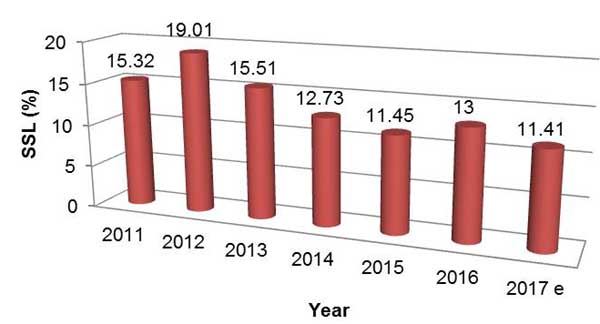
Fig. 1. Self sufficiency level of muton (%), Malaysia
Another initiative for production of local beef is by providing loans to entrepreneurs. Besides, a concept of lending scheme (Pawah Farming System) as the TRUST Loan Scheme (Livestock Entrepreneur Transformation) was established since 2005 by the Malaysian Department of Veterinary Services (Ibhraim et al., 2016). Through this scheme, a number of animals will be handed over to participants who have been approved by the application and then the participants will need to repay the loan either in the form of livestock or cash.
The Malaysian government also focuses on the development of better breed of goats and sheep. R&D on the development of hybrid has been carried out by the Malaysian Agricultural and Development Institute (MARDI), one of the leading agricultural research institutions in Malaysia. One of the programs is the development of Katjang hybrid for better growth rate.
Katjang Goat Potential
Katjang goat (Capra aegagrus hircus) is a Malaysian local indigenous goat (Amie Marini, 2017). In Malaysia, it is also known as Kampung (Village) goat, Kacang goat, Katchang or Licin goat (Ernie et al., 2010). Katjang goats generally are black in color (Picture 1) but dark brown color is also found in this goat breed. It also described to have black line from shoulder to rump (Picture 2). Sometimes white spots are found in the legs and body. Katjang goats are said to be similar to the native goat breeds in Indonesia, Thailand, Philippines, Taiwan and Southwest Japan Island. It is also said to be similar to the South China goat and Bengal Black goat in India. Katjang goats are found in small flocks in some parts of Malaysia and considered to be at risk for extinction. The highest Katjang goat population is found in Kuala Pilah, Negeri Sembilan. Katjang goats can also be found in Kelantan, Terengganu and Kedah in smaller numbers (Picture 3). Usually, these goats are traditionally reared, either by shepherds or breeders in small numbers, about 10 to 20 heads.
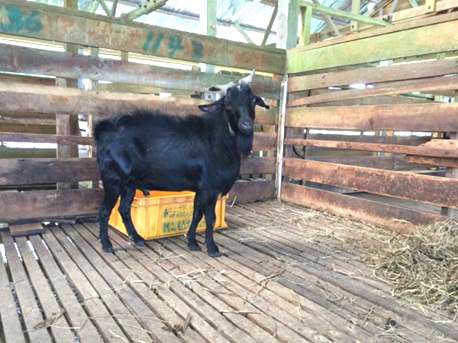
Picture 1
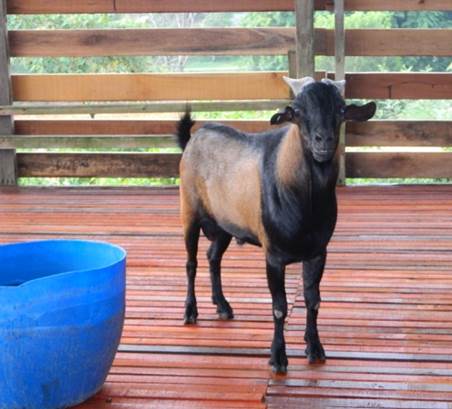
Picture 2
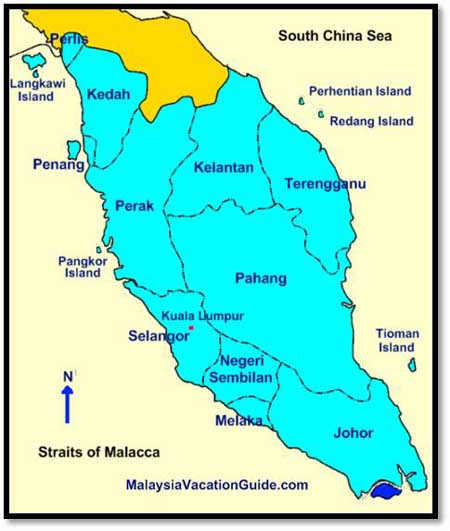
Picture 3
Katjang goats are small in body shape, approximately 45-60 cm and 60-80 cm in height and length, respectively. Although small in size, the Katjang bucks are firmly stout. It has straight and tapered face with short neck, while the ears are aligned horizontally. The birth weight of Katjang kids is only between 1.0 kg and 2.5 kg while the mature weight ranged from 18-27 kg and 25-32 kg for female and male goats, respectively. Due to lack of proper breeding program, high quality replacement breeding animals are hard to be found, thus farmers tend to use the same breeding animals for each generation which increase the possibilities of inbreeding. It results in the decline of size, weight and reproductive performance of Katjang goats.
Katjang goats are highly adapted to the hot and humid tropical environment throughout the year. Other advantages of Katjang goats are the ability to survive in minimal environmental conditions such as consuming low-quality forages and resist towards parasites infestation. Katjang goats are known for its reproductive and prolificacy characteristic (Devendra, 1986). The female has the potential to give twin birth and have good maternal abilities. However, the population of this indigenous goat breed is declining due to crossbreeding program as most breeders are interested to bigger goat breeds such as Boer and Jamnapari.
Imported goat breeds are bigger and heavier compared to local indigenous Katjang goats. Despite larger sizes and higher percentage of meat yield, most of these imported goat breeds have low adaptability towards Malaysian hot and humid climate, resulting in high mortality due to stress, illness and parasite infestation (Hifzan, 2016). The losses it caused among farmers due to high (20%) mortality rate. The inclusion of these breeds only meet the demand for goat meat but not suitable for breeding purposes.
In early 2000, Boer goats were brought into Malaysia. MARDI was the first government organization that evaluated its performance under the Malaysian environment (Abdul Rashid et al., 2005). The imported Boer goats from Australia and South Africa were reared for meat production under intensive or semi-intensive production systems. Unfortunately, these imported goats failed to express their optimum potential in term of reproductive efficiency and growth under the Malaysian environment. Many farmers experienced high mortality rates and poor growth performance (Hifzan et al., 2017).
Hence, a systematic breeding plan has been developed to improve the performance and potential of this goat. Through the RMK-11 (2016-2020) Malaysian development project, MARDI received funds which amounted to RM 4.2 million (US$1.02 million) to develop a synthetic goat breed by the cross-breeding of Katjang and Boer goats. The Boer goat has a leading role to play in helping to feed the third world countries, since it can be used in crossbreeding programs to improve the quality and body weight of indigenous goats (Malan, 2000). Katjang goats are known for their reproductive prolificacy, robustness, highly adaptability to local climate and resistance towards parasitic infestation. However, they are low in growth rate and meat yield, therefore by the infusion of Boer goat genotype of high meat yield and growth rate, it will increase the heterotic effect towards Katjang goats for meat yield and growth rate (Hifzan et al., 2016). In addition, it will also inherit the superior characteristics of Katjang goat in terms of adaptability and hardiness. Furthermore, through the Katjang-Boer crossbreeding program, it will also produce moderate size goat breed that will meet the farmers’ preferences that are easier to maintain in terms of nutrient requirement and stocking density. The ideal mature weight of goats for Malaysian market is around 45-55 kg/head which is can be met by Katjang hybrid breed goats. The focus of market demand of goats in Malaysia are korban, akikah (Muslim religion festive season) and also for the Indian community in Malaysia. Katjang goat can be improved through crossbreeding program. However, the indigenous genetic resource of pure Katjang goat should not be neglected and it is important to increase the number and quality of purebred Katjang goat for conservation purpose.
Study done by Hifzan et al. (2017) showed that crossbreeding program of Katjang goat seems to be the answer to the poor growth rate and meat yield in this breed (Table 6). By utilizing the imported breed to increase the productivity of Katjang goat, it also will develop new synthetic breeds that are well adapted towards Malaysian climate with high reproductive efficiency.
Table 6. Growth parameters and body measurements of Katjang goats compared to Katjang hybrid, Savanna and Boer goat.

CONCLUSION
Katjang goat hybrid has the potential for commercial production due to its higher growth performance compared to purebred Katjang goats. The size is also moderate and suitable to meet the farmers preferences in low maintenance goat breed. Further research on Katjang hybrid goats will be carried out such as evaluation of every filial generation, production system, precision feeding by production stage, and carcass characterization to establish it as the future superior breeds for Malaysian industry. By end of year 2020, the full package of Katjang hybrid production will be provided for animal breeders in Malaysia. Perhaps these efforts will stimulate the increased self-sufficiency level of small ruminant towards 35% by 2020 as targeted by the Malaysian government.
REFERENCES
Abdul Rashid, B., Musaddin. K., Abd. Rahman. M. Y. and M. Y. Mohd Khusahry (2005). Reproductive and Growth Performance of Pure Boer Goats. 26th Malaysian Society of Animal Production Annual Conference, 1-3 June 2005, 9-10.
Amie Marini. A. B., O. M. Firdaus., R.M. Hifzan., J.M. Azwan and S.M. Rosly (2017). Distribution of Indigenous Katjang Goat in Peninsular Malaysia. 5th Biotechnology Symposium, 15 -16 Nov 2017, Ming Garden Hotel, Kota Kinabalu, Sabah, 88.
Ariff, O.M., R. M. Hifzan, A.B. M. Zuki, A. J. Jiken, and S.M. Lehan (2010). Maturing pattern for body weight, body length and height at withers of Jamnapari and Boer goats. Pertanika J. Trop. Agric. Sci., 33(2), 269-276.
Devendra, C. (1986). Pemeliharaan dan Pengeluaran Kambing. Kuala Lumpur. Dewan Bahasa dan Pustaka, 8-11.
Mohd Azwan J., Amie Marini, A. B., Najihah, M., Megan, M.R., Mohamad Hifzan, R., and Norzihan A. (2018). Assesing Breed Composition of Malaysian Katjang Goat with 50K SNP Panel. MARDI Science and Technology Exhibition, 8-10 October 2018, Melaka International Trade Centre (MITC), Ayer Keroh, Melaka, 101-102.
Ernie Muneerah, M.A., S.I. Salleh, A.K. Raymond, I. Zawawi and A.R. Hafiz (2010). Development of Katjang Goat Conservation Centre. Proceeding of the 2nd National Conference on Agrobiodiversity Conservation and Sustainable Utilization, May 11-13, 2010, Tawau, Sabah, 167-169.
Hifzan, R.M., A.W. Mohd Hafiz, A.J. Izuan Bahtiar, A. B. Amie Marini and J.M. Nasir. (2016). Katjang Hybrid: A Potential Goat Breed for Malaysia Small-Ruminant Industry. MARDI Science and Technology Exhibition, 10-13 October 2016, Malaysia Agro Exposition Park Serdang (MAEPS), 71.
Hifzan, R.M., A.W. Mohd Hafiz, A.J. Izuan Bahtiar, M. Predith and J.M. Nasir (2017). Reproductive Performance and Morphological Characteristics of Katjang X Boer Goat. MARDI Science and Technology Exhibition, 18-19September 2016, Malaysia Agro Exposition Park Serdang (MAEPS), 61.
Hifzan, R.M., A.W. Mohd Hafiz, A.J. Izuan Bahtiar, A. B. Amie Marini and J.M. Nasir. (2017). Pre and Post-Weaning Growth Performance of Katjang x Boer Goats. ARCAP4 and 38th Malaysian Society of Animal Production Annual Conference, 27-30 August 2017, Johor, 73-74.
Ibhraim, M. R., Niteh, M. Y., and Ahmad, M. (2016). Sistem Penternakan Haiwan Secara Pawah: Permasalahan Dari Sudut Syariah (Pawah Farming System From Sharia Perspective). e-Bangi.
Malan, S.W. (2000). The Improved Boer Goat. Small Ruminant Research, l6, I82-1 88.
Nor Amna, A. M. N. and Hifzan, R. (2015). The Development and Future Direction of Malaysia’s Livestock Industry. FFTC Agricultural Policy Articles. Retrieved on 24th October 2018 at http://ap.fftc.agnet.org/ap_db.php?id=529
Rafiu, O.Y., Zainura, Z.N., Ahmad, H.A., MohdAriffin, A.H., and Mohd Fadhil, M.D. (2012). Greenhouse gas emissions: Quantifying methane emissions from livestock. Am. J. Engg. & Applied Sci. 5(1):1 – 8.
|
Date submitted: Nov. 12, 2018
Reviewed, edited and uploaded: Dec. 11, 2018
|


Manipulating of Katjang Goat Genetic Material for Sustainable Goat Industry in Malaysia
INTRODUCTION
Goat is one of the important industries in the agro-food subsector in Malaysia. In 2017, the value of this industry is about RM175.55 million (US$42.81 million). Goat provides nutrition for Malaysian people through the supply of meats and milk. However, the goat industry in Malaysia is relatively small. Currently, the population of goats and sheep in Malaysia is around 572,000 animals that could supply around 4,600 MT of mutton a year. On the other hand, the consumption of mutton in Malaysia is around 40,388 MT a year. As a result, Malaysia imports around 51,150 live goats and sheep, and 34,984 MT of mutton mainly from Australia, New Zealand, South Africa and India. The Malaysian government aims to increase the production of mutton so as to reduce the dependency of meats from foreign countries. Many plans and initiatives have been spelled out in the Malaysian Development Plan and the National Agricultural Policy. This paper highlights one of the initiatives of the Malaysian Agricultural Research and Development Institute (MARDI) towards the development of better goat breeds in Malaysia.
Production and consumption
Production of ruminant livestock such as beef and mutton in Malaysia has shown an increasing trend from 1960 to 2017 (Table 1). In year 2000 up to 2010, the changes of beef and mutton production was the highest percentage of 158.37% and 160.70% respectively. This positive growth was mainly contributed by the rearing of cattle and goats in plantations and also feedlot cattle raised by the private sector (Nor Amna and Mohamad Hifzan, 2015). Additionally, it was also affected by the large expense for livestock, especially ruminants’ sub-sector in the 9th Malaysia Development Plan (RMK-9). A total of RM519.8 million (US$126.8 million) of the total agricultural development budget was allocated by the government to the livestock sector for a period of five years (Mohamed, 2007).
Table 1. Production of beef and mutton in Peninsular Malaysia, 1960 - 2017
e: estimate
Source: Mohamed (2014); Department of Veterinary Services, Malaysia (2018)
The demand for meat in Malaysia shows a higher growth rate if compared with the supply (Table 2). The production of mutton has decreased from time to time. Only quite lately, the production has increased tremendously after the government took special attention and provided incentives. At the same time, the demand for mutton has increased continuously. For example, in 2017, despite the reduction of production by 7.7%, the consumption of mutton has increased around 5.06%.
Table 2. The consumption of beef and mutton in Peninsular Malaysia, 1960 - 2017
Source: Mohamed (2014); Department of Veterinary Services, Malaysia (2018)
The higher demand for meat and meat-based products is associated with higher purchasing power by Malaysian consumers, as well as an increase in the number of population in general. This positive trend can be seen in per capita consumption (Table 3). Before 2010, the per capita consumption of mutton has remained stagnant at below one kilogram per annum. This is affected by the misconception that mutton is high in cholesterol and saturated fats (Kaur, 2010). However, in 2015 and above, the per capita consumption has been more than one kilogram. This shows that, Malaysians began to change their perception and choose mutton as their diet. Per capita consumption of beef, mutton, pork and poultry continue to rise as society growing affluence and having higher purchasing power.
Table 3. Per capita consumption of meat in Peninsular Malaysia (kg), 1993-2017
Source: Mohamed (2014); Department of Veterinary Services, Malaysia (2018)
Livestock trade
Most of livestock products in Malaysia, except for poultry, rely on imports to satisfy its domestic demands . Compared to other meats, beef is the most imported meat in Malaysia. It is due to cheaper price compared to the local beef price and also has a high demand from Malaysian consumers. The value of imported mutton during the period of 2015 and 2016 is relatively high, RM469 million (US$114.4 million) in 2015 and just decreased a bit to RM454.17 million in 2016 (US$110.8 million) (Table 4).
Table 4. Import Value of Livestock and Livestock Products in Malaysia, 2015 - 2016
Source: Ministry of Agriculture and Agro-Based Industry Malaysia
Although mutton production has increased over the past eight years, Malaysia is still unable to meet the mutton demand for its population, as well as for export purposes. The number of exports for mutton is very small as shown in the Table 5. Hence, this leads to a negative trade balance value. Indeed, the balance of trade for live animals (for consumption) and meat as a whole is negative, with the negative value of RM2,567.49 million (US$626.2 million) for live animals and RM1,779.05 (US$433.9 million) for meat in 2016 (Department of Veterinary Services, 2018).
Table 5. Export Value of Mutton, Live Sheep and Live Goats in Malaysia, 2012 - 2016
Source: Ministry of Agriculture and Agro-Based Industry Malaysia
Government intervention on goat industry
The Government of Malaysia, through the Ministry of Agriculture and Agro-based Industry, has outlined a number of new measures and approaches to strengthen the Malaysian livestock industry. In the 9th Malaysia Plan (2006-2010), several large-scale projects have been developed to increase the population of cattle and goats. While in the 10th Malaysia Plan (2011-2015), livestock was also given priority in the Northern Corridor Economic Region (NCER), East Coast Economic Region (ECER), the Sarawak Corridor of Renewable Energy (SCORE) and the Sabah Development Corridor (SDC). During the 10th Malaysia Plan period, livestock was also focused on economic growth efforts in the National Key Economic Areas (NKEA). In agriculture’s NKEA, 16 Entry Point Projects (EPPs) have been identified to catalyze the establishment of market-driven, industrial scale and integrated-related business. Some of these EPPs are focusing on the livestock sector. Most recently, the 11th Malaysia Plan (RMK-11) focuses on research and development (R&D) especially on agricultural practices that take into account the climate change and Good Agricultural Practices (GAPs). It will be expanded to 500 fruit and vegetable farms, 160 livestock farms and 65 new aquaculture farms.
A government incentive to increase livestock population especially in the goat industry is highlighted by the importation of selected goat breeds. A majority of goat breeds in Malaysia are from Indonesia, India, Australia, South Africa and other countries. Goats like Anglo Nubian, Jamnapari, Boer, Savanna, Kalahari Red and others have flooded and colored the goat population in Malaysia (Azwan et al., 2018). These goat breeds were brought in to Malaysia mainly to increase the population and further accommodate local demand for goats (Ariff et al., 2010). In general, self-sufficiency levels for Malaysian goats and sheep are small, hovering around 11% to 13% from 2011 to 2016 (Figure 1). In 2011, the self-sufficiency level for mutton was 15.32% and decreased to 13% in 2016 (Department of Veterinary Service, 2018). Many efforts have been taken by the Malaysian government to achieve a targeted self-sufficiency at 35% - a feat which requires an increment of more than 1.5 million heads of goats and sheep by 2020 (Rafiu et al., 2012).
Fig. 1. Self sufficiency level of muton (%), Malaysia
Another initiative for production of local beef is by providing loans to entrepreneurs. Besides, a concept of lending scheme (Pawah Farming System) as the TRUST Loan Scheme (Livestock Entrepreneur Transformation) was established since 2005 by the Malaysian Department of Veterinary Services (Ibhraim et al., 2016). Through this scheme, a number of animals will be handed over to participants who have been approved by the application and then the participants will need to repay the loan either in the form of livestock or cash.
The Malaysian government also focuses on the development of better breed of goats and sheep. R&D on the development of hybrid has been carried out by the Malaysian Agricultural and Development Institute (MARDI), one of the leading agricultural research institutions in Malaysia. One of the programs is the development of Katjang hybrid for better growth rate.
Katjang Goat Potential
Katjang goat (Capra aegagrus hircus) is a Malaysian local indigenous goat (Amie Marini, 2017). In Malaysia, it is also known as Kampung (Village) goat, Kacang goat, Katchang or Licin goat (Ernie et al., 2010). Katjang goats generally are black in color (Picture 1) but dark brown color is also found in this goat breed. It also described to have black line from shoulder to rump (Picture 2). Sometimes white spots are found in the legs and body. Katjang goats are said to be similar to the native goat breeds in Indonesia, Thailand, Philippines, Taiwan and Southwest Japan Island. It is also said to be similar to the South China goat and Bengal Black goat in India. Katjang goats are found in small flocks in some parts of Malaysia and considered to be at risk for extinction. The highest Katjang goat population is found in Kuala Pilah, Negeri Sembilan. Katjang goats can also be found in Kelantan, Terengganu and Kedah in smaller numbers (Picture 3). Usually, these goats are traditionally reared, either by shepherds or breeders in small numbers, about 10 to 20 heads.
Picture 1
Picture 2
Picture 3
Katjang goats are small in body shape, approximately 45-60 cm and 60-80 cm in height and length, respectively. Although small in size, the Katjang bucks are firmly stout. It has straight and tapered face with short neck, while the ears are aligned horizontally. The birth weight of Katjang kids is only between 1.0 kg and 2.5 kg while the mature weight ranged from 18-27 kg and 25-32 kg for female and male goats, respectively. Due to lack of proper breeding program, high quality replacement breeding animals are hard to be found, thus farmers tend to use the same breeding animals for each generation which increase the possibilities of inbreeding. It results in the decline of size, weight and reproductive performance of Katjang goats.
Katjang goats are highly adapted to the hot and humid tropical environment throughout the year. Other advantages of Katjang goats are the ability to survive in minimal environmental conditions such as consuming low-quality forages and resist towards parasites infestation. Katjang goats are known for its reproductive and prolificacy characteristic (Devendra, 1986). The female has the potential to give twin birth and have good maternal abilities. However, the population of this indigenous goat breed is declining due to crossbreeding program as most breeders are interested to bigger goat breeds such as Boer and Jamnapari.
Imported goat breeds are bigger and heavier compared to local indigenous Katjang goats. Despite larger sizes and higher percentage of meat yield, most of these imported goat breeds have low adaptability towards Malaysian hot and humid climate, resulting in high mortality due to stress, illness and parasite infestation (Hifzan, 2016). The losses it caused among farmers due to high (20%) mortality rate. The inclusion of these breeds only meet the demand for goat meat but not suitable for breeding purposes.
In early 2000, Boer goats were brought into Malaysia. MARDI was the first government organization that evaluated its performance under the Malaysian environment (Abdul Rashid et al., 2005). The imported Boer goats from Australia and South Africa were reared for meat production under intensive or semi-intensive production systems. Unfortunately, these imported goats failed to express their optimum potential in term of reproductive efficiency and growth under the Malaysian environment. Many farmers experienced high mortality rates and poor growth performance (Hifzan et al., 2017).
Hence, a systematic breeding plan has been developed to improve the performance and potential of this goat. Through the RMK-11 (2016-2020) Malaysian development project, MARDI received funds which amounted to RM 4.2 million (US$1.02 million) to develop a synthetic goat breed by the cross-breeding of Katjang and Boer goats. The Boer goat has a leading role to play in helping to feed the third world countries, since it can be used in crossbreeding programs to improve the quality and body weight of indigenous goats (Malan, 2000). Katjang goats are known for their reproductive prolificacy, robustness, highly adaptability to local climate and resistance towards parasitic infestation. However, they are low in growth rate and meat yield, therefore by the infusion of Boer goat genotype of high meat yield and growth rate, it will increase the heterotic effect towards Katjang goats for meat yield and growth rate (Hifzan et al., 2016). In addition, it will also inherit the superior characteristics of Katjang goat in terms of adaptability and hardiness. Furthermore, through the Katjang-Boer crossbreeding program, it will also produce moderate size goat breed that will meet the farmers’ preferences that are easier to maintain in terms of nutrient requirement and stocking density. The ideal mature weight of goats for Malaysian market is around 45-55 kg/head which is can be met by Katjang hybrid breed goats. The focus of market demand of goats in Malaysia are korban, akikah (Muslim religion festive season) and also for the Indian community in Malaysia. Katjang goat can be improved through crossbreeding program. However, the indigenous genetic resource of pure Katjang goat should not be neglected and it is important to increase the number and quality of purebred Katjang goat for conservation purpose.
Study done by Hifzan et al. (2017) showed that crossbreeding program of Katjang goat seems to be the answer to the poor growth rate and meat yield in this breed (Table 6). By utilizing the imported breed to increase the productivity of Katjang goat, it also will develop new synthetic breeds that are well adapted towards Malaysian climate with high reproductive efficiency.
Table 6. Growth parameters and body measurements of Katjang goats compared to Katjang hybrid, Savanna and Boer goat.
CONCLUSION
Katjang goat hybrid has the potential for commercial production due to its higher growth performance compared to purebred Katjang goats. The size is also moderate and suitable to meet the farmers preferences in low maintenance goat breed. Further research on Katjang hybrid goats will be carried out such as evaluation of every filial generation, production system, precision feeding by production stage, and carcass characterization to establish it as the future superior breeds for Malaysian industry. By end of year 2020, the full package of Katjang hybrid production will be provided for animal breeders in Malaysia. Perhaps these efforts will stimulate the increased self-sufficiency level of small ruminant towards 35% by 2020 as targeted by the Malaysian government.
REFERENCES
Abdul Rashid, B., Musaddin. K., Abd. Rahman. M. Y. and M. Y. Mohd Khusahry (2005). Reproductive and Growth Performance of Pure Boer Goats. 26th Malaysian Society of Animal Production Annual Conference, 1-3 June 2005, 9-10.
Amie Marini. A. B., O. M. Firdaus., R.M. Hifzan., J.M. Azwan and S.M. Rosly (2017). Distribution of Indigenous Katjang Goat in Peninsular Malaysia. 5th Biotechnology Symposium, 15 -16 Nov 2017, Ming Garden Hotel, Kota Kinabalu, Sabah, 88.
Ariff, O.M., R. M. Hifzan, A.B. M. Zuki, A. J. Jiken, and S.M. Lehan (2010). Maturing pattern for body weight, body length and height at withers of Jamnapari and Boer goats. Pertanika J. Trop. Agric. Sci., 33(2), 269-276.
Devendra, C. (1986). Pemeliharaan dan Pengeluaran Kambing. Kuala Lumpur. Dewan Bahasa dan Pustaka, 8-11.
Mohd Azwan J., Amie Marini, A. B., Najihah, M., Megan, M.R., Mohamad Hifzan, R., and Norzihan A. (2018). Assesing Breed Composition of Malaysian Katjang Goat with 50K SNP Panel. MARDI Science and Technology Exhibition, 8-10 October 2018, Melaka International Trade Centre (MITC), Ayer Keroh, Melaka, 101-102.
Ernie Muneerah, M.A., S.I. Salleh, A.K. Raymond, I. Zawawi and A.R. Hafiz (2010). Development of Katjang Goat Conservation Centre. Proceeding of the 2nd National Conference on Agrobiodiversity Conservation and Sustainable Utilization, May 11-13, 2010, Tawau, Sabah, 167-169.
Hifzan, R.M., A.W. Mohd Hafiz, A.J. Izuan Bahtiar, A. B. Amie Marini and J.M. Nasir. (2016). Katjang Hybrid: A Potential Goat Breed for Malaysia Small-Ruminant Industry. MARDI Science and Technology Exhibition, 10-13 October 2016, Malaysia Agro Exposition Park Serdang (MAEPS), 71.
Hifzan, R.M., A.W. Mohd Hafiz, A.J. Izuan Bahtiar, M. Predith and J.M. Nasir (2017). Reproductive Performance and Morphological Characteristics of Katjang X Boer Goat. MARDI Science and Technology Exhibition, 18-19September 2016, Malaysia Agro Exposition Park Serdang (MAEPS), 61.
Hifzan, R.M., A.W. Mohd Hafiz, A.J. Izuan Bahtiar, A. B. Amie Marini and J.M. Nasir. (2017). Pre and Post-Weaning Growth Performance of Katjang x Boer Goats. ARCAP4 and 38th Malaysian Society of Animal Production Annual Conference, 27-30 August 2017, Johor, 73-74.
Ibhraim, M. R., Niteh, M. Y., and Ahmad, M. (2016). Sistem Penternakan Haiwan Secara Pawah: Permasalahan Dari Sudut Syariah (Pawah Farming System From Sharia Perspective). e-Bangi.
Malan, S.W. (2000). The Improved Boer Goat. Small Ruminant Research, l6, I82-1 88.
Nor Amna, A. M. N. and Hifzan, R. (2015). The Development and Future Direction of Malaysia’s Livestock Industry. FFTC Agricultural Policy Articles. Retrieved on 24th October 2018 at http://ap.fftc.agnet.org/ap_db.php?id=529
Rafiu, O.Y., Zainura, Z.N., Ahmad, H.A., MohdAriffin, A.H., and Mohd Fadhil, M.D. (2012). Greenhouse gas emissions: Quantifying methane emissions from livestock. Am. J. Engg. & Applied Sci. 5(1):1 – 8.
Date submitted: Nov. 12, 2018
Reviewed, edited and uploaded: Dec. 11, 2018